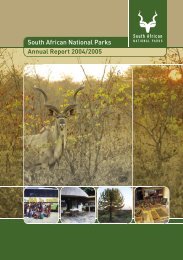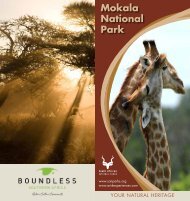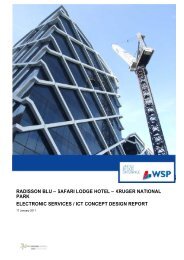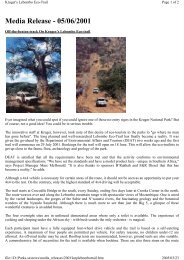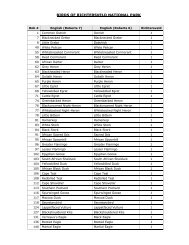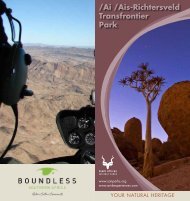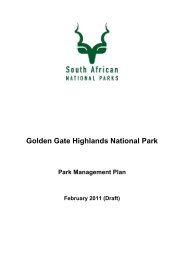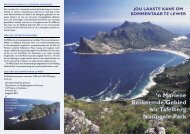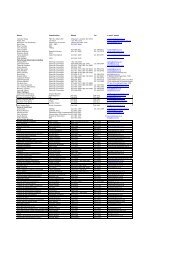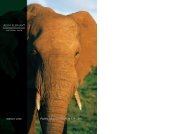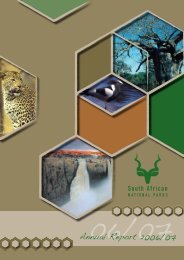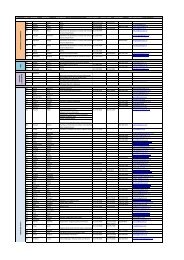PARKBESTUURSPLAN RICHTERSVELD ... - SANParks
PARKBESTUURSPLAN RICHTERSVELD ... - SANParks
PARKBESTUURSPLAN RICHTERSVELD ... - SANParks
Create successful ePaper yourself
Turn your PDF publications into a flip-book with our unique Google optimized e-Paper software.
landscape was also examined in order to identify sites where<br />
objectives (especially the conservation of the protected area’s natural systems and its<br />
biodiversity) can continue in appropriate areas. Use zones serve to ensure that high<br />
intensity facilities and activities are placed in areas that are robust enough to tolerate<br />
intensive use, as well as to protect more sensitive areas of the park from over-utilization.<br />
PARK USE ZONATION SYSTEM<br />
The zoning system<br />
<strong>SANParks</strong> has adopted a dual zoning system for its parks. The system comprises:<br />
a) Visitor use zones covering the entire park, and<br />
b) Special management overlays which designate specific areas of a park that require special<br />
management interventions.<br />
The zoning of Richtersveld National Park is shown in Map 4, and summarised in Table One.<br />
The Zoning process and its linkage to the underlying environmental analysis<br />
The park use zonation plan is a lean version of the Conservation Development Framework<br />
(CDF). The park use zonation is based on the same biodiversity and landscape analyses<br />
undertaken for a CDF. However, certain elements underlying the CDF may not be fully incorporated<br />
into the park use zonation. In particular, the park use zonation plan will usually not<br />
incorporate elements such as a full tourism market analysis. Typically the park use zonation<br />
approach is applied in smaller and developing parks such as Richtersveld National Park,<br />
though the long term objective is to have a full CDF for all parks.<br />
The zoning for Richtersveld National Park was underpinned by an analysis and mapping of<br />
the sensitivity and value of a park’s biophysical, heritage and scenic resources. This analysis<br />
examined the biophysical attributes of the park including habitat value (in particular the contribution<br />
to national conservation objectives), special habitat value (the value of the area to<br />
rare and endangered species), hydrological sensitivity (areas vulnerable to disruption of<br />
hydrological processes such as floodplains and wetlands), topographic sensitivity (steep<br />
slopes), soil sensitivity (soils that are vulnerable to erosion) and vegetation vulnerability to<br />
physical disturbance. In addition, the heritage value and sensitivity of sites was examined<br />
(including archaeological, historical and current cultural aspects). The visual sensitivity of the<br />
Table 2: Summary of the percentage area of the park covered by each zone, as well as the<br />
percentage of the highly environmentally sensitive and valuable areas (defined as areas<br />
with values in the top quartile of the sensitivity value analysis) that are in each zone.<br />
infrastructure development could have a strong aesthetic<br />
impact. This analysis was used to inform the appropriate use of<br />
different areas of the park, as well as to help define the boundaries<br />
between zones. The zoning was also informed by the<br />
park’s current infrastructure and tourism products, as well as the<br />
regional context (especially linkages to neighbouring areas and<br />
impacts from activities outside the reserve). Planned infrastructure<br />
and tourism products were also accommodated where<br />
these were compatible with the environmental informants.<br />
These were all interpreted in the context of the park objectives.<br />
This was undertaken in an iterative and consultative process.<br />
Map 5 shows the relationship between the use zoning and the<br />
summary products of the biodiversity and landscape sensitivityvalue<br />
analysis. This indicates that in this park it was possible to<br />
include most of the environmentally sensitive and valuable areas<br />
into zones that are strongly orientated towards resource conservation<br />
rather than tourist use. Table 2 summarises the percentage<br />
area of the park covered by each zone, as well as the percentage<br />
of the highly environmentally sensitive and valuable<br />
areas (defined as areas with values in the top quartile of the sensitivity<br />
value analysis) that are in each zone. Almost 85% of the<br />
park is covered by zones that are strongly conservation orientated<br />
in terms of their objectives (i.e. Remote and Primitive), with<br />
almost 70% being in the most strongly conservation orientated<br />
zone (Remote). The correlation between the spatial distribution<br />
of environmentally sensitive habitats and the conservation orientated<br />
zones is very strong in this park, with the Remote zone<br />
containing almost 96% of the highly sensitive habitats. The<br />
tourism orientated Low Intensity Leisure zone covers approximately<br />
15% of the park yet contains only around 2% of the most<br />
sensitive habitats.<br />
Remote Zone<br />
Characteristics:<br />
This is an area retaining an intrinsically wild appearance and<br />
character, or capable of being restored to such, and which is<br />
undeveloped and roadless. There are no permanent improvements<br />
or any form of human habitation. It provides outstanding<br />
opportunities for solitude with awe inspiring natural characteristics.<br />
If present at all, sight and sound of human habitation and<br />
activities are barely discernable and at far distance. The zone<br />
also serves to protect sensitive environments from development<br />
impacts and tourism pressure.<br />
Visitor activities and experience:<br />
Activities: Access is strictly controlled and on foot. Groups must<br />
be small, and can either be accompanied by a guide or unaccompanied.<br />
Several groups may be in area at the same time if<br />
necessary, but densities and routes should be defined so that no<br />
signs can be seen or heard between the groups. The principles<br />
of “Pack it in Pack it out” must be applied.<br />
Interaction with other users: There is no interaction between<br />
groups. The numbers of groups within the area will be determined<br />
by the ability to ensure that there is no interaction<br />
between groups.<br />
Objectives of the zone (Limits of acceptable change):<br />
Biophysical environment: Deviation from a natural/pristine state<br />
should be minimized, and existing impacts should be reduced.<br />
Aesthetics and recreational environment: Activities which<br />
impact on the intrinsically wild appearance and character of the<br />
area, or which impact on the wilderness characteristics of the<br />
area (solitude, remoteness, wildness, serenity, peace etc) will<br />
not be tolerated.<br />
Facilities:<br />
Type and size: No facilities are provided. Should overnight facilities<br />
be required to serve this zone, these should be placed in<br />
the adjoining zones.<br />
Sophistication of facilities: No facilities except self carried<br />
portable tents. Guidelines for washing, ablution and cooking<br />
must be defined according to the “Pack it in Pack” it out principles.<br />
Camping is permitted only at designated sites.<br />
Audible equipment and communication structures: None.<br />
Access and roads: Public access is non-motorized. Vehicular<br />
access and parking is provided in the adjoining Primitive zone.<br />
Established footpaths may be provided where erosion risks<br />
occur.<br />
Location in Park:<br />
In Richtersveld NP, Remote areas were largely designated in<br />
rugged mountainous areas less utilized for small-stock grazing.<br />
These areas were identified to include most landscapes with<br />
high environmental sensitivity and value, especially those areas<br />
with high concentrations of rare and endemic species.<br />
Primitive Zone:<br />
Characteristics:<br />
The prime characteristic of the zone is the experience of wilderness<br />
qualities with the accent on controlled access. Access is<br />
controlled in terms of numbers, frequency and size of groups.<br />
The zone shares the wilderness qualities of Wilderness Areas<br />
and Remote zones, but with the provision of basic self-catering<br />
facilities and access. It also provides access to the Remote zone<br />
and Wilderness Area. Views of human activities and development<br />
outside of the park may be visible from this zone.<br />
This zone has the following functions:<br />
It provides the basic facilities and access to serve Wilderness<br />
Areas and Remote zones.<br />
It contains concession sites and other facilities where impacts<br />
are managed through strict control of the movement and numbers<br />
of tourists, for example, all tourists are in concession safari<br />
vehicles.<br />
It serves as a buffer to the fringe of the park and other zones, in<br />
particular Wilderness and Remote.<br />
It serves to protect sensitive environments from high levels of<br />
development.<br />
Visitor activities and experience:<br />
Activities: Access is controlled in terms of numbers, frequency<br />
R I C H T E R S V E L D N A S I O N A L E P A R K • P A R K B E S T U U R S P L A N<br />
84<br />
85



